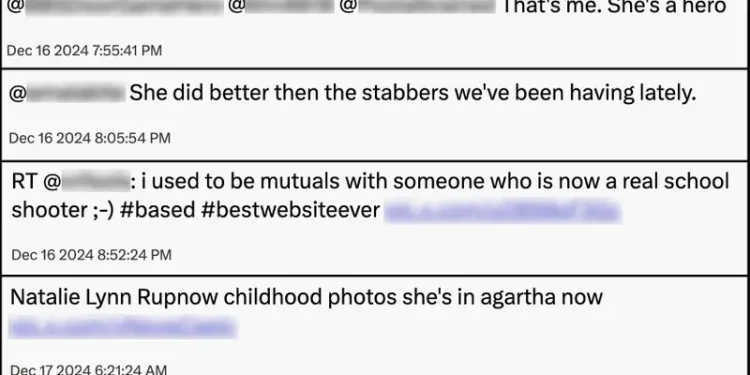This article has been produced for the network of local propuplica reports in partnership with Wisconsin Watch. Register for dispatches To obtain stories like this as soon as they are published.
A few moments before Natalie Rupnow, 15, opened fire inside her Madison, Wisconsin, school, two people and herself last month, a social media account that would be hers Published a photo on X showing someone sitting in a bathroom stand and flashes a hand gesture that has become a symbol of white supremacy.
While the news from the shooting broke, another X user replied: “Live”.
The researchers of extremism now believe that the second story belonged to Solomon Henderson, 17, who, according to the police, entered his cafeteria in the secondary in Nashville, in Tennessee on Wednesday and fired 10 shots, killing a comrade of class then himself. The archives of another X account linked to him that he has published a photo similar to Rupnow’s in his last moments.
Although there is no evidence that Rupnow and Henderson plotted their attacks together, the researchers in extremism who had followed their activity on social networks told Wisconsin Watch and Propublica that the two adolescents were active in the same networks Online that glorifies mass shooters, even following paths. On various social media platforms, networks exchange hate memes alongside terrorist literature, to exchange advice on how to effectively commit attacks and to encourage each other to make their own.
Researchers have been following these networks for months in the course of work online extremist networks that have proliferated on game, discussion and social media platforms and they believe they are radicalizing young people to mass and other violence.
The researchers’ analysis revealed only a few cases in which Rupnow and Henderson seemed to interact directly. But in the hours, the days and weeks following the Madison shooting, Henderson seems to have set himself on Rupnow. He boasted on x that Rupnow and he were “mutuals”, a common internet term to follow each other, and shared another article which said: “I was mutuals with someone who is Now a real school shooter 😉 ”.

Credit:
Obtained by Wisconsin Watch and Propublica. Screenshots by propublica. Blored by Propublica.
The researchers, who have collaborated with organizations to combat terrorism, academics and police to prevent violence by following the way in which extremist networks radicalize young people online, have agreed to share information as long as ‘They were not appointed out of concerns for their physical security. The media checked their references with several experts in the field.
It is impossible to know with complete certainty that online accounts belong to private people without specialized access to the devices and accounts of the police. The Nashville Metropolitan Police Department has recognized the existence of two documents they believe that Henderson has created, which both contain details on its social media accounts. Other researchers and groups – including the anti -division league, the Canadian extremism expert Marc -André Argentino and the Intelligence Group site – also determined that these probably belonged to Henderson.
The researchers of extremism linked accounts to Rupnow, who went by Samantha, by drawing his activity through several social media profiles which have revealed common biographical details, including personal knowledge and that it lived in the Wisconsin. On the bathroom post, a person on whom the account regularly interacted with Rupnow by his nickname, “Sam”. Wisconsin Watch and Propublica were able to verify publications on social networks and the links between accounts by retracing the stages of researchers through archived accounts of social media and screenshots.
ABC News cited sources of application of the law in the report on Thursday that a social media account linked to Henderson may have been in contact with Rupnow’s social media account. The information examined by Wisconsin Watch and Propublica details their alleged connections and interactions. Almost all the accounts that the researchers have linked to Rupnow and Henderson have now been suspended.
A spokesperson for the Madison police department said that the agency knew that RUPNOW “was very active on social networks” and that it “begins to start to receive and examine the documents of technological companies. The police of the police Nashville said that she had nothing more to add beyond their previous statements.
Rubi Patricia Vergara, 14, and Erin West, 42, were killed at an abundant Christian school in Madison. Josselin Corea Escalante, 16, died in Antioch High School in Nashville. The two attackers also committed suicide.
RUPNOW and Henderson each had several X -accounts, WISCONSIN Watch and Propublica extremes told researchers. At the time of his attack, Rupnow only followed 13 other users. Two of these accounts were linked to Henderson.
In November, Rupnow shared a Henderson position, who seemed to wish a good day of the veterans to the man who killed more than a dozen people at the University of Texas in Austin in 1966.
After the attack on Madison, someone wrote to Henderson and others on X, saying that one of their “friends” may have “killed a school”. Henderson told another user: “I barely know her” and said that he had never exchanged private messages with her. Later, in a 51 -page screed that the Nashville police examine, he imitated and rented several old attackers, including Rupnow and said: “I have links with some of them only via messaging platforms in line.”
After the Rupnow shooting, Henderson described it as “saintrontresse”, using a common term in the networks, and has published or was given messages on his tens of times, celebrating his genocidal online racist personality and the fact that she had taken measures. On a platform, he used a photo of her as a profile photo. In his writings, he said that he had scribbled the name of Rupnow and those of the other authors of his weapon and his equipment.
Online networks that the two inhabited adolescents have a range of influences, ideologies and aesthetics. To various degrees of engagement and sincerity, they attribute to white, anti -Semitic, racist, neonazis, occult or Satanic supremacist beliefs.
In this online world, the currency that buys influence is violence. This violence often involves children and adolescents harming other children and adolescents, some by doxing or encouraging autumutilation, others, like Rupnow and Henderson, by committing mass attacks in the non -virtual world.
“This network is better described as an online subculture which celebrates violent attacks and radicalizes young people in the violation of violence,” said one of the researchers in prevention of violence. “Many people involved in this network are minors, and we would like to see an intervention to give them the help and support they need, for their own security as well as those around them.”
The members of some of these communities, including Terrorgram, 764 and Com, have engaged in online and offline activities that led to convictions for having had sexual abuse materials for children and sexually exploiting a child and Acts of accusation to request crimes of hatred and request the murder of federal officials. Affairs are pending and the defendants did not file any answers to the courts. This month, the US State Department has appointed the Terrorgram collective as a terrorist organization, saying that “the group promotes violent white supremacism, requests attacks against perceived adversaries and provides advice and teaching materials on Tactics, methods and targets for attacks, in particular on infrastructure and official government criticism. »»
When the details of the Nashville shootout began to emerge, the researchers realized that they had seen certain accounts and publications of Henderson in the network of a hundred users they follow. They had previously pointed out a username of an account belonging to Henderson, as well as other members of the network, to the police and submitted several reports to the national center for missing and exploited children.
They had not been aware of Rupnow’s accounts before her attack, but were able to locate her in the network after the fact, discovering that she had regularly interacted with other accounts that they had followed.
Alex Newhouse, researcher at extremism at the University of Colorado, Bouder, said that these subcultures have a long history of lionization and imitation of previous attackers while passing for adoption as much violence as possible – Even by attributing “scores” to past attacks, something Henderson has engaged with online. “The antioche is very obviously copycat,” said Newhouse.
Although Henderson’s newspaper said he was considering an attack for months before that of Rupnow, his shooting drew his attention. A few hours later, he retweeted another article which said: “There should be a Paris market for which the RW Twitter figure will radicalize the next shooter.” (RW means the right.)
However, the two adolescents entered this online subculture, their writings reveal the despair of their personal life and the world around them and expressed violent and hateful opinions.
After the Madison shooting, a separate social media user noted his association and tweeted in the FBI, accusing Henderson and others of having a previous warning. They “must be locked up,” said the poster: “No question asked.”
The FBI refused to comment. After Henderson’s attack, social media users returned to the tweet: “Hey, so this guy literally ended up calling a future school shooter a month in advance and the FBI did nothing subject.”
Mollie Simon contributed to research.


